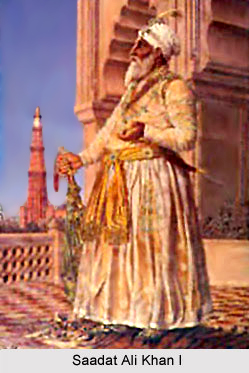 Saadat Ali Khan, also known as Saadat Ali Khan I, was the Subahdar Nawab of Awadh and the son of Muhammad Nasir. He became the Subahdar Nawab of Awadh on 26th January 1722 and remained in the position till the year 1739. When he was 25 years of age, Saadat Ali accompanied Muhammad Nasir, his father, and participated in the final campaign of Aurangzeb, the Mughal Emperor to stand against the Maratha in the Deccan. Emperor Aurangzeb honorably awarded him the title Khan Bahadur for his commitment and unfaltering services. Saadat Ali Khan I was born as Muhammad Amin Musawi to father Muhammad Nasir Musawi, who was a Shia Muslim merchant of Khurasan. During the reign of the Mughal Emperor Shah Jahan, his grandfather migrated to India. His father became a very important official during the rule of Bahadur Shah I. Saadat Ali Khan is the progenitor of the Nawabs of Awadh.
Saadat Ali Khan, also known as Saadat Ali Khan I, was the Subahdar Nawab of Awadh and the son of Muhammad Nasir. He became the Subahdar Nawab of Awadh on 26th January 1722 and remained in the position till the year 1739. When he was 25 years of age, Saadat Ali accompanied Muhammad Nasir, his father, and participated in the final campaign of Aurangzeb, the Mughal Emperor to stand against the Maratha in the Deccan. Emperor Aurangzeb honorably awarded him the title Khan Bahadur for his commitment and unfaltering services. Saadat Ali Khan I was born as Muhammad Amin Musawi to father Muhammad Nasir Musawi, who was a Shia Muslim merchant of Khurasan. During the reign of the Mughal Emperor Shah Jahan, his grandfather migrated to India. His father became a very important official during the rule of Bahadur Shah I. Saadat Ali Khan is the progenitor of the Nawabs of Awadh.
Rule of Saadat Ali Khan I
After the inauguration of the reign of Muhammad Shah, Saadat Ali Khan I was appointed as the faujdar or garrison commander of Bayana. He received the title of Saadat Khan Bahadur. He became governor of Agra on 15th October, 1720 AD. Saadat Ali Khan was given the title of Captain of the Imperial Body Guards on 12th January, 1721 AD. Later in the year 1722 AD, he became the governor of Awadh and also became the army-in-charge of Gorakhpur on 9th September, 1722 AD, with the title of Saadat Khan in place of Raja Girdhar, who became the governor of Malwa. Under him, Awadh included 5 districts, namely, Lucknow, Bahraich, Gorakhpur, Faizabad and Khalilabad. The borders of the region extended to Kannauj in west, Bihar in east, Himalayan hills in north and Kara-Manikpur of Allahabad province in south. The province was 230 miles wide with a total of 1,01,71,080 Bigha in area, from Gorakhpur to Kannauj and from northern hills to Kara-Manikpur.
Since the reign of Aurangzeb, The region was engulfed in chaos and mismanagement that was created by the local kings, jagirdars and zamindars. Saadat Ali Khan implemented several steps to bring the situation in control and to improve the condition of the province. He constructed a palace near Ayodhya and established the city of Faizabad and made it the capital of the new government. Due to his effective management policies, the financial condition of the province improved. Due to his efforts for the betterment of the state and the people, Muhammad Shah gave him the title of Burhan-ul-Mulk, as he was very pleased with his service.
In 1728 AD, Saadat Ali Khan I expanded the periphery of the state on the eastern border by bringing Chunar, Ghazipur, Jaunpur and Banaras under his rule from Jagirdar Murtaza Khan. He was also one of the prominent commanding Mughal generals during the Battle of Karnal which was fought against Nadir Shah.
Saadat Ali Khan, the Subahdar Nawab of Awadh was captured in the battle and he died in the year 1739, the night before the mass execution in Delhi by Nadir Shah. He was buried in the mausoleum of Sayadat Khan, his brother, at Delhi. He had only one daughter who was married to the son of Sayadat Khan, named Abul Mansur Khan Safdar Jung (Muhammad Muqim), who became the next government of Awadh by succeeding Saadat Ali Khan I.



















